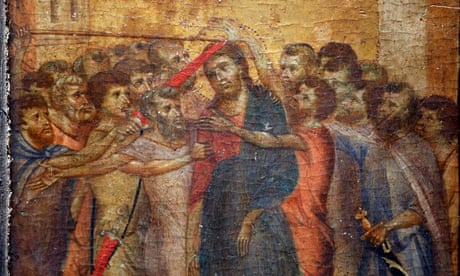Eight layers of varnish had drowned iconic painting’s colours over time, as coating became yellow with oxidation
Philip Oltermann
European culture editor

Tue 30 Apr 2024
For almost 200 years, she has been the definitive symbol of the French republic. Now, after a much-needed facelift, Eugène Delacroix’s Liberty Leading the People will rise above the fray of revolutionary anarchy in her true colours once more.
The 19th-century painter’s world-famous and widely copied Liberty Leading the People, depicting a bare-chested woman brandishing the French flag and leading armed men into battle, will be hung again at the Louvre art museum on Thursday, after a six-month effort to remove decades of varnish and grime.
Often assumed to depict the French Revolution of 1789, Delacroix’s artwork was made in 1830 to commemorate the July Revolution that toppled King Charles X of France the same year.
Bought by the French state the year after and housed at the Louvre since 1874, it has become the definitive depiction of the personified France, known as Marianne, and an icon of revolutionary insurrections.

For almost 200 years, she has been the definitive symbol of the French republic. Now, after a much-needed facelift, Eugène Delacroix’s Liberty Leading the People will rise above the fray of revolutionary anarchy in her true colours once more.
The 19th-century painter’s world-famous and widely copied Liberty Leading the People, depicting a bare-chested woman brandishing the French flag and leading armed men into battle, will be hung again at the Louvre art museum on Thursday, after a six-month effort to remove decades of varnish and grime.
Often assumed to depict the French Revolution of 1789, Delacroix’s artwork was made in 1830 to commemorate the July Revolution that toppled King Charles X of France the same year.
Bought by the French state the year after and housed at the Louvre since 1874, it has become the definitive depiction of the personified France, known as Marianne, and an icon of revolutionary insurrections.

View image in fullscreen‘We’re the first generation to rediscover the colour,’ says Sébastien Allard, the Louvre’s director of paintings. Photograph: Abdullah Firas/ABACA/REX/Shutterstock
The painting has been re-interpreted by countless modern artists, and versions of the image have appeared on banknotes, album sleeves, book covers and political placards at protests around the world.
The original, however, gradually lost its expressive powers over the years due to what contemporary restorers now say were misguided attempts by their predecessors to trap the painting’s glory in time.
Eight layers of varnish were applied to Liberty Leading the People over the years in a bid to brighten its colours, but instead ended up drowning them under a coating of drab yellow as the varnish oxidised on the surface.
The painting has been re-interpreted by countless modern artists, and versions of the image have appeared on banknotes, album sleeves, book covers and political placards at protests around the world.
The original, however, gradually lost its expressive powers over the years due to what contemporary restorers now say were misguided attempts by their predecessors to trap the painting’s glory in time.
Eight layers of varnish were applied to Liberty Leading the People over the years in a bid to brighten its colours, but instead ended up drowning them under a coating of drab yellow as the varnish oxidised on the surface.

View image in fullscreenThe painting, pictured here before restoration, had lost its original colours due to excessive varnishing, according to restorers. Photograph: Dimitar Dilkoff/AFP/Getty Images
The colours, “the whites, the shadows – all of this ended up melting together under these yellowish layers”, Sébastien Allard, director of paintings at the Paris museum, told Agence France-Presse. “We’re the first generation to rediscover the colour,” he added.
The painting was removed from its traditional place at the Louvre on 20 September 2023 and replaced with Ary Scheffer’s Les Femmes souliotes, which used to hang opposite.

Louvre acquires €24m painting originally destined for rubbish tip
Due to Liberty’s large size – 2.6 metres x 3.25 metres (8.5ft x 10.5ft) – the restoration works took place on site at the museum.
Curator Côme Fabre told AFP that specialists started by analysing the artwork using x-ray, ultraviolet and infrared radiation, comparing their discoveries with archive images of the painting.
In the process, Fabre said, “they even discovered that certain alterations, including a brown mark on Liberty’s dress, had been added after Delacroix and could therefore be removed”.
The Louvre, the largest museum in the world, has carried out about 200 restorations since 2015, including of Leonardo da Vinci’s La Belle Ferronnière, Titian’s Pardo Venus and several by Delacroix including Women of Algiers and the Massacre at Chios.
The colours, “the whites, the shadows – all of this ended up melting together under these yellowish layers”, Sébastien Allard, director of paintings at the Paris museum, told Agence France-Presse. “We’re the first generation to rediscover the colour,” he added.
The painting was removed from its traditional place at the Louvre on 20 September 2023 and replaced with Ary Scheffer’s Les Femmes souliotes, which used to hang opposite.

Louvre acquires €24m painting originally destined for rubbish tip
Due to Liberty’s large size – 2.6 metres x 3.25 metres (8.5ft x 10.5ft) – the restoration works took place on site at the museum.
Curator Côme Fabre told AFP that specialists started by analysing the artwork using x-ray, ultraviolet and infrared radiation, comparing their discoveries with archive images of the painting.
In the process, Fabre said, “they even discovered that certain alterations, including a brown mark on Liberty’s dress, had been added after Delacroix and could therefore be removed”.
The Louvre, the largest museum in the world, has carried out about 200 restorations since 2015, including of Leonardo da Vinci’s La Belle Ferronnière, Titian’s Pardo Venus and several by Delacroix including Women of Algiers and the Massacre at Chios.
No comments:
Post a Comment